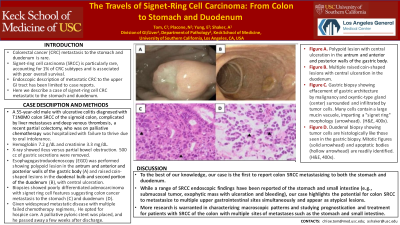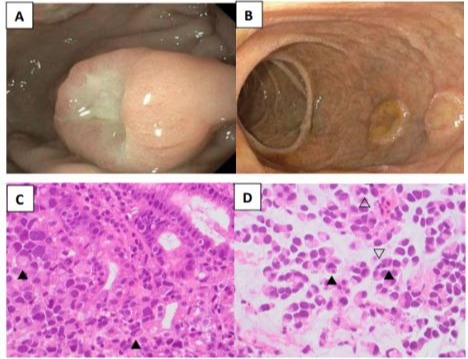Tuesday Poster Session
Category: General Endoscopy
P3426 - The Travels of Signet-Ring Cell Carcinoma: From Colon to Stomach and Duodenum
Tuesday, October 24, 2023
10:30 AM - 4:00 PM PT
Location: Exhibit Hall

Has Audio

Chloe K. Tom, MD
Keck School of Medicine of USC
Los Angeles, CA
Presenting Author(s)
Chloe K. Tom, MD, Nicholas Placone, MD, Evan Yung, MD, Anisa Shaker, MD
Keck School of Medicine of USC, Los Angeles, CA
Introduction: Colorectal cancer (CRC) metastasis to the stomach and duodenum is rare. Signet-ring cell carcinoma (SRCC) is particularly rare, accounting for 1% of CRC subtypes and is associated with poor overall survival (1). Endoscopic description of metastatic CRC to the upper GI tract has been limited to case reports. Here we describe a case of signet-ring cell CRC metastatic to the stomach and duodenum.
Case Description/Methods: A 55-year-old male with colon SRCC status post-partial colectomy, with liver metastases, on palliative chemotherapy was hospitalized with one week of failure to thrive due to oral intolerance. He was frail and had a distended, but non-tender abdomen. Laboratory tests were notable for microcytic anemia with hemoglobin 7.2 g/dL and acute kidney injury with creatinine 3.3 mg/dL.
Plain x-ray showed concern for ileus versus partial bowel obstruction and 500 cc of gastric secretions were removed with nasogastric tube. Given concern for gastric outlet obstruction, he underwent an esophagogastroduodenoscopy (EGD) which revealed polypoid lesion in the stomach (A) and multiple raised coin-shaped lesions in the duodenum (B), all with central ulceration. Biopsies of the gastric and duodenal lesions showed poorly differentiated adenocarcinoma with signet ring cell features suggesting colon cancer metastasis to the stomach (C) and duodenum (D). Given widespread metastatic disease with multiple failed chemotherapy regimens, he opted for hospice care. A palliative pyloric stent was placed, and he passed away a few weeks after discharge.
Discussion: To the best of our knowledge, our case is the first to report colon SRCC metastasizing to both the stomach and duodenum. While there has been a range of endoscopic findings for SRCC of the stomach and small intestine from mimicking a submucosal tumor to an exophytic mass with ulceration and bleeding, our case highlights the potential for colon SRCC to metastasize to multiple upper gastrointestinal sites simultaneously and appear as atypical lesions during endoscopic evaluation. More research is warranted in characterizing common macroscopic patterns and studying prognostication and treatment plans for patients with SRCC of the colon with multiple sites of metastasis such as the stomach and small intestine.
1. Puccini A, Poorman K, Catalano F, et al. Molecular profiling of signet-ring-cell carcinoma (SRCC) from the stomach and colon reveals potential new therapeutic targets. Oncogene. 2022;41(26):3455-3460. doi:10.1038/s41388-022-02350-6

Disclosures:
Chloe K. Tom, MD, Nicholas Placone, MD, Evan Yung, MD, Anisa Shaker, MD. P3426 - The Travels of Signet-Ring Cell Carcinoma: From Colon to Stomach and Duodenum, ACG 2023 Annual Scientific Meeting Abstracts. Vancouver, BC, Canada: American College of Gastroenterology.
Keck School of Medicine of USC, Los Angeles, CA
Introduction: Colorectal cancer (CRC) metastasis to the stomach and duodenum is rare. Signet-ring cell carcinoma (SRCC) is particularly rare, accounting for 1% of CRC subtypes and is associated with poor overall survival (1). Endoscopic description of metastatic CRC to the upper GI tract has been limited to case reports. Here we describe a case of signet-ring cell CRC metastatic to the stomach and duodenum.
Case Description/Methods: A 55-year-old male with colon SRCC status post-partial colectomy, with liver metastases, on palliative chemotherapy was hospitalized with one week of failure to thrive due to oral intolerance. He was frail and had a distended, but non-tender abdomen. Laboratory tests were notable for microcytic anemia with hemoglobin 7.2 g/dL and acute kidney injury with creatinine 3.3 mg/dL.
Plain x-ray showed concern for ileus versus partial bowel obstruction and 500 cc of gastric secretions were removed with nasogastric tube. Given concern for gastric outlet obstruction, he underwent an esophagogastroduodenoscopy (EGD) which revealed polypoid lesion in the stomach (A) and multiple raised coin-shaped lesions in the duodenum (B), all with central ulceration. Biopsies of the gastric and duodenal lesions showed poorly differentiated adenocarcinoma with signet ring cell features suggesting colon cancer metastasis to the stomach (C) and duodenum (D). Given widespread metastatic disease with multiple failed chemotherapy regimens, he opted for hospice care. A palliative pyloric stent was placed, and he passed away a few weeks after discharge.
Discussion: To the best of our knowledge, our case is the first to report colon SRCC metastasizing to both the stomach and duodenum. While there has been a range of endoscopic findings for SRCC of the stomach and small intestine from mimicking a submucosal tumor to an exophytic mass with ulceration and bleeding, our case highlights the potential for colon SRCC to metastasize to multiple upper gastrointestinal sites simultaneously and appear as atypical lesions during endoscopic evaluation. More research is warranted in characterizing common macroscopic patterns and studying prognostication and treatment plans for patients with SRCC of the colon with multiple sites of metastasis such as the stomach and small intestine.
1. Puccini A, Poorman K, Catalano F, et al. Molecular profiling of signet-ring-cell carcinoma (SRCC) from the stomach and colon reveals potential new therapeutic targets. Oncogene. 2022;41(26):3455-3460. doi:10.1038/s41388-022-02350-6

Figure: A: Esophagogastroduodenoscopy (EGD) reveals polypoid lesion with central ulceration in the stomach.
B: EGD reveals multiple raised coin-shaped lesions with central ulceration in the duodenum.
C: Gastric biopsy showing effacement of gastric architecture by malignancy and oxyntic-type gland (center) surrounded and infiltrated by tumor cells. Many cells contain a large mucin vacuole, imparting a "signet ring" morphology (arrowhead). (H&E, 400x)
D: Duodenal biopsy showing tumor cells are histologically like those seen in the gastric biopsy. Mitotic figures (solid arrowhead) and apoptotic bodies (hollow arrowhead) are readily identified. (H&E, 400x)
B: EGD reveals multiple raised coin-shaped lesions with central ulceration in the duodenum.
C: Gastric biopsy showing effacement of gastric architecture by malignancy and oxyntic-type gland (center) surrounded and infiltrated by tumor cells. Many cells contain a large mucin vacuole, imparting a "signet ring" morphology (arrowhead). (H&E, 400x)
D: Duodenal biopsy showing tumor cells are histologically like those seen in the gastric biopsy. Mitotic figures (solid arrowhead) and apoptotic bodies (hollow arrowhead) are readily identified. (H&E, 400x)
Disclosures:
Chloe Tom indicated no relevant financial relationships.
Nicholas Placone indicated no relevant financial relationships.
Evan Yung indicated no relevant financial relationships.
Anisa Shaker indicated no relevant financial relationships.
Chloe K. Tom, MD, Nicholas Placone, MD, Evan Yung, MD, Anisa Shaker, MD. P3426 - The Travels of Signet-Ring Cell Carcinoma: From Colon to Stomach and Duodenum, ACG 2023 Annual Scientific Meeting Abstracts. Vancouver, BC, Canada: American College of Gastroenterology.
